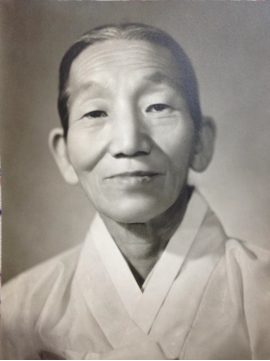BY KYUNG-NYUN KIM RICHARDS

The author’s grandmother.
I didn’t learn how to dress myself in my hanbok until I was in my teens. Everything from putting on the layers of under-garments to tying the bow on the cho-ko-ri, the short jacket, has to be done properly. I remember how my Halmoni (grandmother) burst out laughing when I asked her about what to do if I had to use the bathroom.
My Halmoni was born on March 27, 1897, by the lunar calendar and died on April 7, 1980, at the age of 83. Her maiden name was Paik and her first name Yu-Hyun. She married my grandfather at the age of 14. Her first child was born when she was 19, and she became a grandmother at age 44 when I was born. Practically everything I know about Korean culture — as well as how to live — I learned from her.
One of the first things my Halmoni taught me was how to pronounce certain Korean words. One should not speak the way the words were written – noon (with a long “oo”) meant “snow” but nun (with a short “u”) meant “eye”. She also taught me the proper forms and uses of honorific speech and how to make the great ceremonial bow, so important during ancestral memorial ceremonies (je-sa) and holiday tea-ceremonies called cha-rye. My grandmother’s insight and attention to language affected me so deeply that I ended up studying and teaching languages all my life.
When I was applying to high school, it was my grandmother who insisted I apply to Kyung-Gi Girls’ High School, the top high school for girls in those days. I was unsure if I could pass its entrance exam, but my grandmother discovered that my homeroom teacher was holding special sessions on how to take tests and signed me up immediately. If it weren’t for her help and encouragement – who knows what might have otherwise happened to me on my educational path?
When I left Korea in 1967, I had little inkling of what the future held for me. I was planning to go back home in two years. And besides, I was 26 and still young enough to think that my grandmother would live forever.
Though my family had strongly objected, I married someone outside of the Korean community. And in 1974, I took my husband and our one-year-old son to Korea for a month, mainly to introduce them to my grandmother. After our return to the US, she wrote to me that she missed us. It is one of my many regrets that I did not see her again before she died.
My grandmother taught me that the secret of looking proper in a hanbok, was in the undergarments: layers of very wide-legged pantaloons made of fine silk. On a social occasion years ago at the Asian Art Museum in San Francisco, I was dressed in one of my grandmother’s creations. A friend commented that my Korean dress looked like “a piece of cloud.” I know my grandmother would have been proud.
This is an excerpt from a full length piece that will be featured in an anthology by Asian Women United. For inquiries and submissions, please contact motherofallstories@gmail.com.
